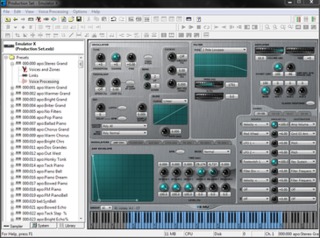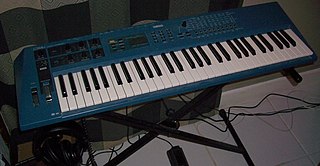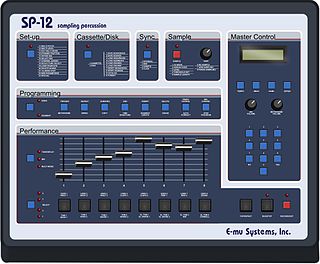Emagic was a music software and hardware company based in Rellingen, Germany and a satellite office in Grass Valley, California. On July 1, 2002 Emagic was bought by Apple Computer. Emagic's Windows-based product offerings were discontinued on September 30, 2002.
Ensoniq Corp. was an American electronics manufacturer, best known throughout the mid-1980s and 1990s for its musical instruments, principally samplers and synthesizers.
A rompler is an electronic musical instrument that plays pre-fabricated sounds based on audio samples. The term rompler is a blend of the terms ROM and sampler. In contrast to samplers, romplers do not record audio. Both may have additional sound editing features, such as layering several waveforms and modulation with ADSR envelopes, filters and LFOs.

The Emulator is a series of digital sampling synthesizers using floppy-disk storage that was manufactured by E-mu Systems from 1981 until 2002. Although it was not the first commercial sampler, the Emulator was innovative in its integration of computer technology and was among the first samplers to find widespread usage among musicians. While costly, its price was considerably lower than those of its early competitors, and its smaller size increased its portability and, resultantly, practicality for live performance. The line was discontinued in 2002.
Doepfer Musikelektronik GmbH is a German manufacturer of audio hardware, mostly synthesizer modules, based in Gräfelfing, Upper Bavaria and founded by Dieter Döpfer. The product range covers analog modular systems, MIDI controllers, MIDI hardware sequencers, MIDI-to-CV/Gate/Sync Interfaces, MIDI master keyboards and special MIDI equipment.
Electribe is a group of electronic musical instruments by Korg. From its beginnings with the Electribe R to the ESX-1, this series includes both analogue modeling synthesizers and sampling drum machines that can be programmed the same as a drum machine. The analogue modeling synth and sampling drum machine both share a drum-pattern section and a synth-pattern section, whereby the user can not only program drum patterns, but also synth and basslines. These hybrid machines could be considered 'grooveboxes'.

Waldorf Music is a German synthesizer company. They are best known for the Microwave wavetable synthesizer and Blofeld virtual analogue synthesizer.

The Korg Trinity is a synthesizer music workstation released by Korg in 1995. It was also the first workstation to offer modular expansion for not only sounds, but also studio-grade feature such as ADAT, various sound engine processors, audio recording capability, and more. It was considered one of the most comprehensive music workstations, in term of features, at the time.

Emulator X is a software-based audio sampler that was produced by E-MU Systems from 2004 to 2009.
Cheetah Marketing was a United Kingdom-based company that produced electronic music-related hardware products and software for home computer systems during the 1980s. They later changed their name to Cheetah International Ltd.

Sound Blaster Live! is a PCI add-on sound card from Creative Technology Limited for PCs. Moving from ISA to PCI allowed the card to dispense with onboard memory, storing digital samples in the computer's main memory and then accessing them in real time over the bus. This allowed for a much wider selection of, and longer playing, samples. It also included higher quality sound output at all levels, quadrophonic output, and a new MIDI synthesizer with 64 sampled voices. The Live! was introduced in August 1998 and variations on the design remained Creative's primary sound card line into the early 2000's.

The Sound Blaster AWE32 is an ISA sound card from Creative Technology. It is an expansion board for PCs and is part of the Sound Blaster family of products. The Sound Blaster AWE32, introduced in March 1994, was a near full-length ISA sound card, measuring 14 inches (356 mm) in length, due to the number of features included.

The Roland JD-800 is a digital synthesizer that was manufactured between 1991 and 1996. It features many knobs and sliders for patch editing and performance control — features that some manufacturers, including Roland, had been omitting in the name of streamlining since the inception of the Yamaha DX7. The JD-800 thus became very popular with musicians who wished to take a hands-on approach to patch programming. The introduction in the manual states that Roland's intention with the JD-800 was to "return to the roots of synthesis".
The Yamaha SY85 is a digital music workstation introduced in 1992. Unlike other Yamaha synthesizers of the time the SY85 does not use FM synthesis. Instead, its sounds are based on samples, which can be layered and modified to create new sounds.

The Yamaha CS1x is a sample-based synthesizer released by the Yamaha Corporation in 1996.

Quasimidi Musikelektronik GmbH was a German synthesizer manufacturer from Hesse. It was founded in 1987 by Friedhelm Haar and Jörg Reichstein. It was originally based in Kirchhain, but moved to Rauschenberg in 1998. The company folded in 2000.
The Roland JD-990 Super JD is an updated version of a Roland JD-800 synthesizer in a form of a module with expanded capabilities, which was released in 1993 by Roland Corporation. JD-990 is a multitimbral synthesizer utilising PCM sample-based synthesis technology. In a sense it is not a true module version of a JD-800 as it has many expanded features and as a result the two are incompatible in exchanging presets. It is equipped with 6 MB of ROM containing sampled PCM waveforms, four sets of stereo outputs that are assignable to individual, internal, instruments, and standard MIDI in/out/through ports. JD-990 has a large LCD display and programming takes place through a keypad on the front panel of the unit. The unit can generate multi-timbral sounds reminiscent of the vintage analogue synthesizers but is also capable of generation of modern digital textures. There are several expansion boards available for JD-990 that can be installed in the provided expansion slot in the chassis of the unit.
Digital Sound Factory is a sound design company that creates sound libraries, known as SoundFont libraries, for playback on synthesizers and computers compatible with Steinberg Cubase, Cakewalk Sonar, Reasonstudios, Steinberg Halion, Native Instruments Kontakt, Apple GarageBand, Apple Logic, Ableton Live, GenieSoft Overture, Finale, Creative Labs Audigy/X-Fi, E-MU Systems EmulatorX/Proteus X, LMMS, FL Studio, MuseScore, Mixcraft, VSamp, SFZ, SynthFont, Ardour, FluidSynth and more.

The E-mu Proteus was a range of digital sound modules and keyboards manufactured by E-mu Systems in the late twentieth century.

E-mu SP-12 also known as the “sampling drum computer” was designed in 1985 and widely released in 1986 by E-mu Systems. Although the SP-12 was quickly superseded by the more powerful SP-1200, the SP-12 is often regarded as the first commercially successful drum machine and sampler combo.























